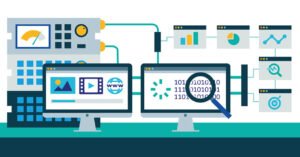Best Open Source Data Analytics Tools of 2023: Top 6

Do you know Best Open Source Data Analytics Tools of 2023: Top 6? The comparison of data analytics tools is explained in this post. Making wise decisions and taking advantage of opportunities and inefficiencies in your industry will help you stand out from the competition. In fact, the development of data analytics technologies during the digital era greatly facilitated this. In 2021 and beyond, analysing data will be commonplace, to the point where access to completely free and open-source information analytics tools is available to all users.
However, there are a lot of open-source data analytics tools available, thus in order to maximise your analytics efforts, you must choose your tools carefully.
Here are some specifics about this article’s comparison of data analytics tools:
Here is a list of our top recommendations for the greatest open-source data analytics tools that you can use to create and implement analytical processes and make more wise business decisions.
Read More:How to enable dark mode in Google app
1. Grafana

Grafana is an open-source platform for information analytics that enables you to monitor metrics across numerous programmes and databases. Along with real-time insights into external systems, you receive signals that notify you when specific events occur.
With the aid of customizable control panels, DevOps engineers commonly use the software to monitor their systems, run analytics, and pull up metrics that make big data understandable.
Grafana allows you to visualise your data using geomaps, heatmaps, charts, and histograms, making it simpler to comprehend. Additionally, you get to group your information for better context and describe information simply where it makes sense. Compare big data and data science as well.
The software programme gives you options for using it, such as the Cloud, or you can rapidly instal it on any platform. Additionally, you can gather your team to exchange data and control panels and find a variety of plugins and dashboards in its primary library.
Grafana supports more than 30 additional open-source & commercial data sources, allowing you to access data from virtually any location. Additionally, you receive an integrated Graphite query parser that makes it quicker than ever to check out and update expressions.
Additionally, the software fits easily into your workflow and may be added to your portfolio of goods and services.
2. Redash
Another well-liked open-source information analytics tool that aids in the transformation of enterprises into data-driven ones is Redash. With the programme, you can link to any data source, display and share your data, and democratise data access inside your organisation.
Without worrying about lock-ins, you can customise and add features, question the reliability of information sources, and enjoy productive collaboration with your friends.
With the aid of the application, you can easily visualise your lead for associates and create outstanding control panels with charts, pivot tables, tables, maps, and more. Additionally, you may gather data from numerous sources, create dashboards or data stories, share them with colleagues via a URL, or embed widgets wherever you need them.
Redash also enables you to create alerts and receive event notifications depending on your data. You can use an API to access the tool if you require more features.
SSO, access control, and other features that result in an enterprise-friendly workflow are included in user management. Although the tool is open-source and lightweight, a cost-effective hosted version is easily accessible if you want to start using it right away.
3. KNIME
KNIME’s Analytics platform, which was first introduced in 2006, has been quickly embraced by the open-source community, businesses, and software providers who utilise it to create data science. The programme is open and simple to use, which makes it simple to understand data. Using the drag and drop graphical user interface, you can create visual workflows, plan your analytical steps while controlling information flow, and make sure your work is up to date.
Additionally, you can combine tools using native KNIME nodes from different domains in a single process. Information from AWS S3, Salesforce, Azure, and other sources can also be accessed and recovered.
When your data is ready, you can create it by gathering statistics, agglomerating, sorting, and registering with data in a database, distributed big data environments, or on your local computer.
The KNIME Analytics Platform also makes use of machine learning and expert systems to create machine learning models for dimension reduction, classification, or regression. Additionally, the tool assists you in improving model performance, validating designs, describing machine learning models, and making predictions directly using either industry-leading PMML or verified models. Check out our guide on updating a jailbroken iPhone to iOS.
Additionally, KNIME enables you to visualise your data using classic scatter plots, bar charts, complex charts such as heat maps, network graphs, sunbursts, and more.
Your company’s information expands along with it. Through multi-threaded information processing and in-memory streaming, KNIME helps you create workflow prototypes and grow workflow efficiency.
The software is excellent for data scientists who lack significant programming abilities but need to include and process data for analytical models and artificial intelligence.
4. RapidMiner
An integrated end-to-end analytics platform can be created with the help of the RapidMiner cloud-based product suite. The item is open-source and has a wide range of features, including automation, which enables it to loop over operations and repeat them, as well as to complete in-database processing automatically.
Real-time scoring is a feature offered by the software programme that enables you to work with other software programmes to implement analytical ideas. Preprocessing, cluster, prediction, and improvement model operationalization is done here.
RapidMiner provides interactive visualisations such as charts and charts that you can access from the platform with zooming, panning, and other moderate drill-down capabilities if you want to look deeper into your data.
You may develop predictive designs and analytics workflows in a unified environment thanks to its drag-and-drop interface.
More than 40 different data kinds, including photos, text, audio, video, social media, and NoSQL, may all be analysed. These data types can be ordered or unorganised.
You may more easily develop big data workflows and combinations using the platform’s code-free user interface.
The fact that RapidMiner is open-source, performs data preparation and ETL in-database for best performance, and speeds up analyses are some of its primary benefits. Additionally, it enables you to create code-free workflows and access the most cutting-edge analytics options, like AI and predictive modelling, for much deeper insights and increased organisational intelligence.
5. RStudio
RStudio is an integrated development environment suite for the R coding language in addition to being an open-source data analytics tool. Using the tool, interactive reports, papers, web apps, and other reporting formats can be created. The software application parses massive data using connections and combinations and in-memory processing. This is made possible by the coding tools built into RStudio for faster, more sophisticated processing of all your data. Check out the top free data recovery programmes as well.
However, if you want more features, you can choose the industrial format, which uses more advanced security and cooperation measures. The completely free version makes use of end-to-end analytics, the connection of APIs, the production and distribution of visualisations, and information consumption.
You can execute R code directly from the source editor with the help of RStudio. In-depth ready-to-install R bundles, comprehensive big data trend analysis, and information usage implementation vessels that make it simple to understand the information you’ve reviewed are all other benefits.
A code editor, web apps, and Flexdashboard for creating interactive control panels are additional features that make RStudio worthwhile of consideration. To help you publish your studies in an appealing manner, RStudio also offers combination with Apache Spark and RStudio Connect.
6. Apache Spark
Unified, open-source analytics engine Apache Glow introduced a new method for processing vast amounts of data quickly and dispersedly. The programme runs quickly, and you can download, edit, and reorganise it for free. You can use it independently or integrate it into your workflow to meet processing needs.
Spark can split data into manageable batches while processing data in real-time, distributing it across clusters, and employing discretized streams. When the data is organised and separated into manageable portions, it may be processed quickly.
Additionally, Glow employs a Cluster Supervisor, allowing for enhanced control over clusters and quick automation and data processing.
Additionally, Glow provides fault tolerance, which helps shield users from crashes and automatically restores lost data and operator status. Your robust distributed datasets will be able to bounce back from node failures in this fashion.
In order to integrate it into your standard process for handling large amounts of data, triggers should support R, Java, Python, Scala, and SQL. Additionally, you get support for API advancement and hundreds of prebuilt plans.
The software programme delivers artificial intelligence at the level of enormous amounts of data, GraphX for system-wide graph-parallel processing and graph formation, data streaming, and connections to almost all popular data sources.
However, security is set by default to off, indicating that your deployments may be vulnerable to assaults. Additionally, it appears that more current versions don’t allow backward compatibility, and you have to change.
Additionally, Apache Spark does not provide traditional support for its products, so you must rely on the open-source community for assistance with issues and paperwork. It also consumes a significant amount of RAM during in-memory processing.











